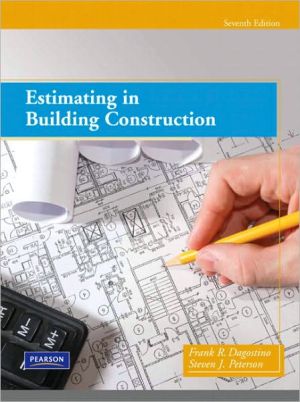GreenSense for the Home: Rating the Real Payoff from 50 Green Home Projects
When does a green home project make financial sense? The authors of this book provide the answer to this and other questions relating to the cost (and relative value) of environmentally friendly home improvements. Eric Corey Freed and Kevin Daum are experts, respectively, in green building and in financing custom homes. In this information-packed book, they walk readers through 50 green home projects and break them down according to the positive impact they have on the environment, as well as...
Search in google:
When does a green home project make financial sense? The authors of this book provide the answer to this and other questions relating to the cost (and relative value) of environmentally friendly home improvements. Eric Corey Freed and Kevin Daum are experts, respectively, in green building and in financing custom homes. In this information-packed book, they walk readers through 50 green home projects and break them down according to the positive impact they have on the environment, as well as the impact they may have (both positive and negative) on the reader’s wallet. They evaluate a wide array of projects, including insulating pipes, weatherizing doors and windows, composting and recycling trash, installing a solar hot water heater, installing green countertops, upgrading appliances, building with reclaimed materials, and installing radiant heat. This unique perspective on going green is a reference that green-leaning homeowners simply cannot do without.
GREEN SENSE FOR THE HOME\ Rating the Real Payoff from 50 Green Home Projects \ \ By Eric Corey Freed Kevin Daum \ The Taunton Press\ Copyright © 2009 Eric Corey Freed and Kevin Daum\ All right reserved.\ ISBN: 978-1-60085-155-1 \ \ \ Chapter One\ 16 green home projects you can do today\ Whether you rent or own your home, these simple projects will help to quickly reduce energy and water usage. All of the projects can be completed in just a day or two, and most are things you can do yourself without any experience.\ 1 Change your light bulbs 8\ 2 Help your toilet use less water 13\ 3 Help your shower use less water 20\ 4 Install occupancy sensors 25\ 5 Install smart strips and kill switches 30\ 6 Install a programmable thermostat 35\ 7 Insulate your water heater 41\ 8 Insulate your pipes 46\ 9 Seal your ducting 50\ 10 Use healthy paints 56\ 11 Weatherize windows and doors 60\ 12 Install solar pool heating 65\ 13 Plant native species and skip the sprinklers 70\ 14 Buy a water filter instead of bottled water 76\ 15 Install a clothesline 80\ 16 Recycle and compost your trash 84\ 1 Change your light bulbs\ ERIC SAYS\ How many environmentalists does it take to change a light bulb? There are several answers to this joke (none of them that funny), but the correct answer is: "all of them." Everyone should swap burned-out incandescent bulbs with energy-efficient compact fluorescent (CFL) ones because upgrading light bulbs is one of the simplest but most effective things you can do to save energy in your home.\ As a nation, we spend more than $37 billion annually just on lighting. In an average home, lighting accounts for 20% to 30% of all electricity use. (At work, that figure goes up to almost 40%.) A CFL uses only a quarter of the energy of an incandescent bulb of the same brightness and lasts much longer than traditional bulbs, meaning less waste and less changing out bulbs.\ What will this project do for your home?\ Traditional bulbs give off 90% heat and only 10% light. A CFL bulb is almost the opposite. An 18-watt CFL provides the same brightness as a 100-watt incandescent bulb, performing the same job and using a fraction of the energy. And the life of a CFL is up to 10,000 hours per bulb compared with less than 1,300 hours for a typical incandescent.\ What will this project do for the Earth?\ Traditional incandescent bulbs waste energy, give off a lot of heat, burn out quickly, and end up in the trash (more than 5.5 million bulbs are thrown away every day)-all of which adds up to more global warming, higher air-conditioning costs, and more waste in already crowded landfills.\ If every American home replaced just one light bulb with a CFL bulb, we would save enough energy to light more than 2.5 million homes for a year and prevent greenhouse gases equivalent to the emissions of nearly 1.2 million cars. If every American household took the additional step of replacing their most-often-used incandescent bulbs with CFLs, electricity use for lighting in the United States could be cut in half.\ Will you need a contractor?\ No. CFL bulbs fit into a standard light bulb socket-they work with your existing light fixtures and do not require any special tools or skills. Switching to CFLs is truly as simple as screwing in a light bulb.\ What are the best sources for materials?\ Compact fluorescents are now available in a variety of shapes and sizes everywhere light bulbs are sold, so you should have no problems finding bulbs to fit any fixture in your home. If you have a unique lamp or fixture, take the existing bulb along to the store to compare sizes. Dimmable CFLs are also available. They cost a little more but will work with existing dimmer switches, whereas a regular CFL will only light up if the dimmer is at the highest setting. CFLs can be used with timers, motion detectors, photocells, and occupancy sensors.\ When CFL bulbs were introduced in the early 1990s, the quality of the light was a big issue-early bulbs gave off light that was cold, antiseptic, and hard to look at-despite the long-lasting energy efficiency of the bulbs. In the last two decades, CFL technology has improved greatly. New color temperatures and warmer bulbs have been introduced, and now the quality is the same or better than that of a traditional bulb.\ All light bulbs have a "color temperature" indicating the warmth of the light. Warmer bulbs are yellowish in color, whereas cooler ones are bluer. Mixing and matching bulbs from different manufacturers can create problems because they may be slightly different colors and not match precisely. To avoid this, buy several cartons of bulbs at a time rather than just a few as you need them.\ If you're worried about the buzzing and flickering problems commonly associated with fluorescent tube lights, don't be. Modern compact fluorescent bulbs use special electronic ballasts to eliminate those issues. Most CFLs are rated for outdoor use, but read the package carefully to make sure if you are installing them in an exterior light.\ How much maintenance will be required after installation?\ There is concern about the mercury trapped inside CFLs, but the small amount of mercury in a CFL-less than 2 milligrams (mg)-is much less than the 10 mg of mercury released into the air by using an incandescent bulb, which requires more coal to be burned (and even more mercury released into the air) to generate the additional electricity required over its lifetime. The average amount of mercury in CFLs has dropped 20% in the past year, and manufacturers continue to reduce the mercury content in the bulbs they produce.\ But CFLs must be recycled, not thrown in the trash. In fact, many states prohibit disposing of any type of fluorescent lamp in the solid-waste stream. Recycling the lamps is simple: Call 800-CLEAN-UP (800-253-2687) or visit the Earth 911 website (www.earth911.com) and enter your zip code to find the nearest recycling center.\ How long will the project take to accomplish?\ Swap out every light bulb in your home to capture the maximum energy savings or do it gradually as incandescent bulbs burn out. Either way, it shouldn't take you more than a minute or so per bulb.\ KEVIN SAYS\ Lighting is a large part of home energy use, and Greenies are going after it in a big way. Laws are being suggested or already on the books in several states to stop use of Thomas Edison's incandescent light bulbs entirely. And technologies such as light-emitting diodes (LED) and Nikola Tesla's inductive (magnetic) lighting are gaining popularity on the CFL-type bulb. They have a ways to go before the cost makes them attractive for everyday use, but expect to see LEDs on a large scale within five to seven years, possibly replacing CFLs entirely.\ The biggest complaint about CFLs is the cold, harsh feel of the light, which is slowly improving. Popular Mechanics did a study on lighting that showed people preferred quality CFL lighting to incandescent bulbs, but many still use incandescent bulbs for their warm tone.\ Then there is the mercury concern. If you break a CFL, you release a small amount of harmful gas into the atmosphere, and when the bulbs burn out, you can't just toss them in the trash.\ What is the capital cost? $\ Obviously, most light bulbs aren't very expensive. Even though a CFL bulb might be three to four times the cost of a normal incandescent bulb, it is still affordable and prices are coming down. An eight-pack of 15-watt CFL bulbs can be found online for $10 to $12 compared with $5 for 60-watt incandescent bulbs. You could incur additional cost if the aesthetics of built-in fixtures require specialized bulbs.\ What financial resources are available? $$$$\ As with most early adopted Green technologies, light bulbs have government support across the country. Energy Star[R] offers rebates for as much as $2 through local government agencies and local stores. A quick online search for "CFL rebates" will yield many coupons and offerings. Also check with your local power company or go to www.energystar. gov to find bulk suppliers. Local university or conservation groups often have free light bulb swaps. Even retailers like The Home Depot[R] and IKEA[R] periodically swap bulbs.\ What is the monthly cost or savings? $$$$$\ Monthly savings for energy-efficient lighting is all over the map, depending on the wattage you buy, how the light is used, and the cost of energy in your area. The accepted rule of thumb is roughly a 75% reduction in energy usage for comparable lighting.\ How long it takes to recoup costs varies widely based upon the quality of lights, the price paid, and how often you use them, since short on-and-off usage shortens a bulb's life span. Assuming conservatively that a CFL bulb lasts eight times longer than an incandescent bulb and costs three times more, the cost of the bulb is quickly recouped and you pick up the energy savings as a bonus. Getting rebates will put you way ahead of the game.\ What is the long-term home value? $\ The impact on home value is nearly nonexistent when it comes to changing light bulbs. The minimal impact on value stems from built-in fixtures. While manufacturers have successfully adapted CFLs to work with dimmers and fit into sockets, many fixtures are designed around the shape and aesthetic of incandescent bulbs. If you invest in new fixtures with CFL technology, you may find it eventually replaced by advances in LED or induction lighting.\ When selling your home, you may need to modernize by changing or upgrading fixtures. At the very least, you will need to invest in bulbs of the right tone and color to help make the house look warm and inviting.\ The Bottom Line Is ...\ It's true the light of CFLs can take getting used to, but the quality is steadily improving. Changing light bulbs equals free money in your pocket and definitely helps the environment. Don't let the CFL mercury complaints deter you either, since the levels are far lower than those found in sushi. Just dispose of CFLs properly when they burn out. That will keep the mercury out of the dumps and away from the water in which your soon-to-be spicy tuna roll may be swimming.\ 2 Help your toilet use less water\ ERIC SAYS\ In the United States, more water is consumed per person than in any other country. One reason is that our homes consume an incredible amount of fresh drinking water, and most of it is used in places it does not need to be so drinkable. More than a quarter of all of the water used inside the home is flushed down the toilet, which is literally a waste. The toilet is the single largest user of clean drinking water in the home, and it is also the easiest place to conserve water. [CHT 2_B]\ Toilets manufactured prior to 1990 use an average of 3.5 gal. (some up to 7 gal.) of water for every single flush. Newer toilets introduced in the 1990s, referred to as "low-flow" toilets, use only 1.6 gal. per flush and cost the same to buy and install as a water-wasting model. Low-flow toilets are required in California, but most states do not yet have these regulations. But before you run out and replace your existing toilets, there are simple and effective things you can do to force your old toilet to use less water, from flush adapters to flusher adjustments and tank tricks. And when the time comes to replace your working toilets, make sure you buy a low-flow model. [CHT 2_C]\ What will this project do for your home?\ Nearly 55 billion gal. of clean, drinkable water is flushed down toilets across the United States each day. Up to half of that amount of water can be saved by using simple water conservation measures, and a onetime retrofit of your toilet will save thousands of gallons of water in your home every year.\ What will this project do for the Earth?\ A worldwide water crisis is looming. In the future, water that was once inexpensive will become unaffordable to many. Making the right choices now will help protect everyone in the near future.\ Will you need a contractor?\ There are a few water-saving options for existing toilets that you can do yourself as well as an inexpensive weekend project that may require the help of a plumber.\ Lowering the toilet tank float manually DWG2_B When you flush the toilet, the water in the tank rushes into the bowl and washes away the waste. A float in the tank drops as the water in the tank drops. This activates a valve to refill the tank with fresh water. As the water rises in the tank, the float rises with it. Once the water level reaches the set height, the valve shuts off.\ By lowering the height of the float, you reduce the amount of water that fills the tank. This project requires a screwdriver (or strong hands), the nerve to stick your hands into the back of the toilet, and 10 minutes.\ There are two types of floats. Older floats are held in place by a metal arm attached with an adjustment screw. Newer floats move up and down along a shaft. With a screwdriver, slowly turn the adjustment screw to lower either type of float. If you don't have a screwdriver handy, you can gently bend the float arm in the center to lower the float. This is a less precise, but handy, alternative.\ That's it. By lowering the float level, you have tricked the toilet into filling with less water. You can save up to 2 gal. of water per flush with this method. Try different heights to find the amount of water that works for you.\ A word of caution: Bending the float arm could hinder the normal operation of the toilet. There is a slight risk you could break the toilet and need rescuing by a real plumber. Only proceed if you're comfortable doing this work.\ Placing a beverage bottle in the back of the tank 2_1, 2_2 You'll need an empty 2-liter soda bottle; sand, marbles, or small pebbles; and about 5 minutes.\ Wash out the bottle and fill it about half to three-quarters of the way with sand, marbles, or small pebbles. Fill it the rest of the way with water and tightly seal the cap.\ Go to your toilet and lift the tank lid. Slip the bottle into the tank as far from the valve in the bottom as possible. Make sure it can stand up by itself. Replace the tank lid. The bottle takes up some of the volume of the tank and will save half a gallon on every flush and thousands of gallons of drinking water a year.\ Installing low- and dual-flush adapters Toilets flush two types of waste: liquid waste and solid waste. Yet regardless of the type of waste, the same amount of water is used to flush the toilet and, 90% of the time, water is wasted.\ If the average toilet uses 3.5 gal. for every flush, a "low-flow" toilet uses 1.6 gal. per flush, and an "ultra-low-flow" requires only 1.1 gal. But a clever alternative is a "dual-flush" toilet. Two flush buttons are located on the toilet. Push one button and the dual-flush uses only 0.8 gal. per flush for liquid waste. For solid waste, push the second button and the full 1.6 gal. is used.\ Rather than replace your entire toilet, a conversion kit can transform your toilet into a dual-flush model. Products like a dual-flush adapter install simply by unscrewing a toilet's existing flush handle and inserting the new handle. [GS2_4]\ What are the best sources for materials?\ All of the systems mentioned can be ordered online direct from the manufacturer. You may also find them in your local hardware store, but it may help to call first. You can find a list of retailers at the manufacturers' respective websites.\ You may be concerned there is a health risk by using these measures in your toilet. Not to worry-you're working on the clean water side of things. None of these installations pose any sort of health issue.\ How much maintenance will be required after installation?\ All of these toilet conversions are virtually maintenance free. You'll see an immediate and noticeable drop in your water bill. Check your usage before and after the installations to see the full impact.\ KEVIN SAYS\ Growing up in Los Angeles in the '70s, I remember putting bricks in toilets during droughts. Now with climate change threatening to bring drought conditions to everyone, I can certainly see the value of water conservation across the board.\ The biggest issue with toilets is flushing power. Luckily, my new hero, engineer Bill Gauley of Veritec Consulting, created what is now the standard flush test, which shows that water volume is only one factor in flushability. Apparently, simply reducing water in some toilets doesn't work effectively due to bowl shape.\ Pressurized retrofit systems now widely used in hotels seem to solve the bowl clearance issues. But the best conservation solution takes advantage of the roughly 5 to 1 ratio of going number 1 to going number 2. The dual toilet allows for lower water usage for most visits and gives extra flow when needed. And dual-flush retrofits mean you don't have to replace the whole toilet.\ (Continues...)\ \ \ \ \ Excerpted from GREEN SENSE FOR THE HOME by Eric Corey Freed Kevin Daum Copyright © 2009 by Eric Corey Freed and Kevin Daum. Excerpted by permission.\ All rights reserved. No part of this excerpt may be reproduced or reprinted without permission in writing from the publisher.\ Excerpts are provided by Dial-A-Book Inc. solely for the personal use of visitors to this web site. \ \
Introduction 216 green home projects you can do today1 Change your light bulbs 82 Help your toilet use less Water 133 Help your shower use low water 204 Install occupancy sensors 255 Install smart strips and kill switches 306 Install a programmable thermostat 357 Insulate your water heater 418 Insulate your pipes 469 Seal your ducting 5010 Use healthy paints 5611 Weatherize windows and doors 6012 Install solar pool heating 6513 Plant native species and skip the sprinklers 7014 Buy a water filter Instead of bottled water 7615 Install a clothesline 8016 Recycle and compost your trash 8421 green me projects an do tomorrow17 Add solar power 9018 Install micro-hydropower 9719 Bring in natural daylighting 10320 Replace your windows 11121 Install a whole-house fan 11722 Insulate your wails and attic 12328 Upgrade your appliances 13124 Upgrade your fireplace 13625 Heat only the water you use 14126 Install a solar hot water heater 14727 Install a cool roof 15328 Pick a green countertop 15829 Cover walls with healthy finishes 16430 Install healthy wall coverings 16831 Replace vinyl with linoleum flooring 17332 Install cork, palm wood, or bamboo Hooting 17833 Install natural carpeting 18334 Use formaldehyde-free wood for cabinetry 18735 Build a composite material deck 19136 Harvest your rainwater 19637 Disassemble, don't Demolish 20213 green home projects you can do when building new38 Reclaim your water, gray and hot 20833 Substitute fly ash for cement in concrete 21540 Incorporate advanced framing techniques 21941 Build with reclaimed materials 22642 Build with recycled drywall 23043 Build with certified wood 23544 Build with engineered lumber 24045 Build with structural insulated panels (SIPs) 24646 Build with Insulating concrete forms (ICFs) 25147 Install radiant heat 25748 Integrate your energy systems 26349 Install a green roof 28850 Utilize passive solar design 273Credits 280Index 281








